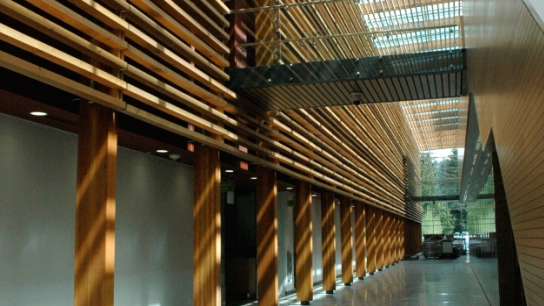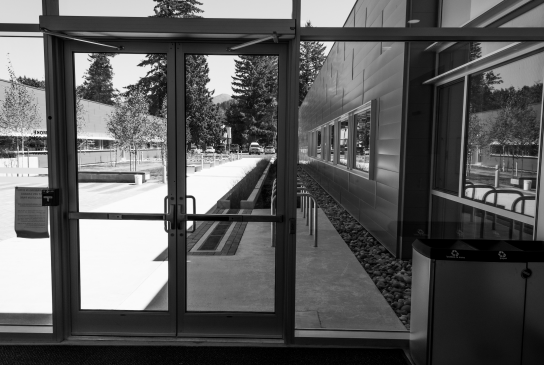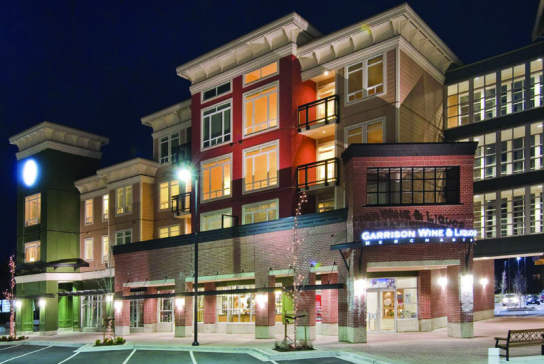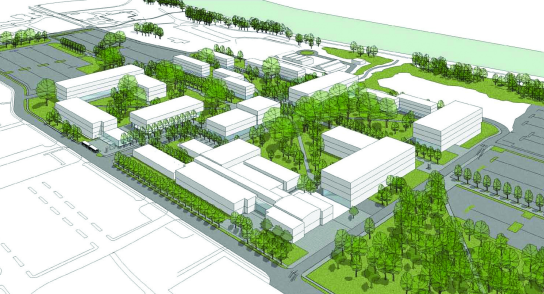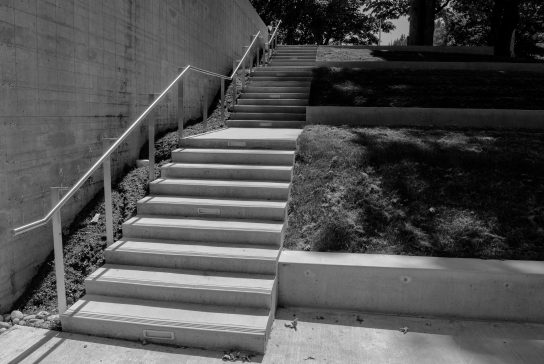Print Edition: October 3, 2012
It seems that everyone is focused on being “green” lately. While most initiatives towards decreasing your carbon foot-print include simple tasks such as recycling and composting, UFV has literally held itself up to the gold standard of “green initiatives.”
The brand new UFV Canada Education Park (CEP) building in Chilliwack isn’t just great for students, but good for the environment as well. With an open source geo-exchange system working its magic and maintaining the temperatures of the building in an eco-friendly manner, solar-thermal heating for the water, and the use of natural lighting throughout the building, the CEP campus really is cutting down on its carbon footprint.
Electric Car Parking Stalls
Even taking it a step further, UFV has created designated electric car parking stalls for those people who drive such vehicles. These stalls allow the driver to charge the vehicle while it is occupying the space, almost acting as a free gas station. While this idea sounds ideal, it does raise some questions as to why these stalls belong at UFV in the first place.
The Ford Focus Electric starts at a mere $37,477, and the Chevrolet Volt at $41,545. The average student probably can’t afford either of these vehicles, so why give prime real estate to electric cars? Faculty or staff may drive electric cars, but are there enough UFV professors driving these kinds of vehicles to warrant special parking stalls?
Craig Toews, UFV’s executive director of Facilities and Campus Development, says that the stalls were a way of planning for the future and keeping UFV true to green standards.
When the new CEP campus was in the designing stages, it was built to attain LEED Gold Certification (Leadership in Energy and Environmental Design).
“The electric car charging stalls are one of a number of sustainable design features required to attain LEED Gold certification for our new building,” Toews explained.
The stalls represent a level of achievement for the campus, but Toews admits the number of stalls may seem disproportionate to the use they’ll see, especially considering they occupy prime real estate.
“While the number of electric stalls implemented at CEP are a little high for that location,” Toews admitted, “it was a LEED requirement and will be reviewed once we have completed the second electric charging project.”
This second electric charging project Toews referred to is the plan to build two more electric car stalls at the Abbotsford campus near C building, as well some at UFV’s Aerospace Centre in Abbostford. These will be built with a grant UFV received from the Fraser Basin Council.
“This funding is to promote electric vehicle use,” Toews continued, “and our Automotive Trades faculty are converting some vehicles to electric to encourage electric vehicle use between campuses.”
So as unnecessary as the electric car parking stalls may seem at the moment to students, their purpose represents great change on a larger scale for the future.
30 Year Plan
The new CEP building was designed and constructed especially with an eye to the future; UFV looks at the new CEP campus as more than just a shiny new building.
With the Garrison Crossing complex just across the road, all the amenities and housing students require are close at hand. Representing the foundation for a university section of the city, Garrison has enabled UFV to expand on their 85 acres at CEP with peace of mind that students will have access to all their needs, both on and off campus.
UFV hopes to add many more buildings to the new campus, and has drawn out a plan for which they anticipate erecting new buildings in which to offer more programs than those currently offered.
For the most part, what UFV has been trying to accomplish since initially purchasing the CEP plot of land in 2006 is to keep up with the growing student population of the Fraser Valley.
“Right now,” Craig Toews explained, “we are [accommodating] five per cent more students than what we are funded for.”
With an ever-growing community, and an ever-growing need for post-secondary education in the workforce, the university is operating beyond its maximum capacity – not a shock to those currently enrolled in classes at UFV.
However, as Toews explained, the money UFV makes from charging tuition is only about 25 per cent of its income.
Eager to expand on the CEP campus as quickly as possible, but faced with a tight budget, the university is relying heavily on government grants, donations, and the funds from parking and the bookstore.
With 55 per cent of the funding tied primarily to the government, it raises the question of how long it may take UFV to expand on the CEP campus to accomplish their 30-year plan.
The Abbotsford campus is facing similar problems; currently operating at a 130 per cent capacity, they are desperate for expansion.
“We have literally renovated every broom closet,” Toews remarked, explaining that in order to expand, new buildings would have to be built in Abbotsford as well.
UFV’s 30-year plan touches on the Abbotsford campus as well, highlighting the potential of a Garrison Crossing-type university residential area across the street. Currently, commercial businesses are occupying the land UFV is interested in for such a project.
The hope, according to Toews, is that UFV will be able to build the “U-District” once an opportunity for purchasing the desired plot of land arises.
Longhouse At CEP
When the new building on the CEP campus was in the planning stages, there was talk of how the building could reflect many things: prosperity, education, culture, and innovation.
One of the ways UFV decided to reflect the culture of Chilliwack was by including an aboriginal longhouse inside the school. The form this takes is not exactly a traditional longhouse although it does hold many characteristics of the classic longhouse.
Continuing with the eco-friendly theme, UFV used mostly recycled cedar wood for the construction of the gathering place. With wood from floor to ceiling, it holds a close-to-nature feel with the modern design reflected in the rest of the buildings architecture.
Storm Drains
Instead of a basic storm drain to collect rain during those torrential downpours, UFV has a storm drain system which works to distribute the water to the planters in the courtyard beyond the cafeteria.
The water runs through a system of pipes that supplies water to the plants around the campus, and cuts down on how much and how often they need to be watered. This also helps to ensure the look and feel of growth and abundance UFV has tried to reflect throughout the building.
The Issues
The campus location is idyllic, but far from perfect.
With an active RCMP gun range on UFV grounds, both students and professors are often distracted by gun fire. Students in Building V (the Agriculture building) complain of not being able to hear instructors over the noise.
Craig Toews shed some light on the topic, stating that the RCMP are currently awaiting funding for the construction of a sound-proof gun range to be built on their own 60 acres of property. Once the funding has been approved, construction will begin, and the gun noises will no longer be a concern on the CEP campus.
There is no definite date attached to this project – but the lease on the current range ends in 2016.
Many students attending the new campus have realized just how far the walk is from the main parking lot to the school. Even with almost 600 parking stalls available between various parking lots, finding a stall at a nearby lot isn’t easy.

